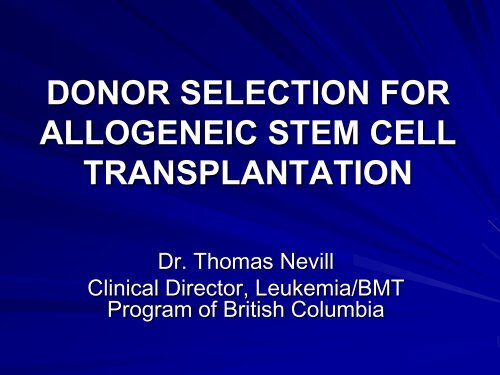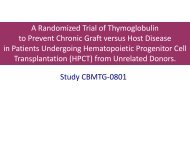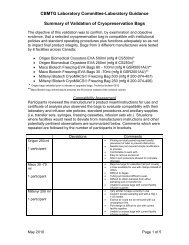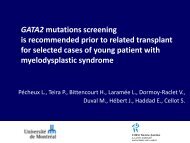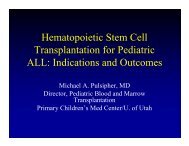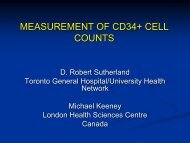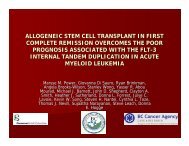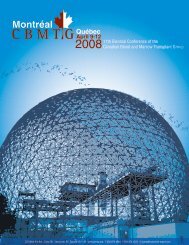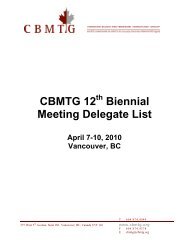DONOR SELECTION FOR ALLOGENEIC STEM CELL ... - CBMTG
DONOR SELECTION FOR ALLOGENEIC STEM CELL ... - CBMTG
DONOR SELECTION FOR ALLOGENEIC STEM CELL ... - CBMTG
- No tags were found...
You also want an ePaper? Increase the reach of your titles
YUMPU automatically turns print PDFs into web optimized ePapers that Google loves.
<strong>DONOR</strong> <strong>SELECTION</strong> <strong>FOR</strong><strong>ALLOGENEIC</strong> <strong>STEM</strong> <strong>CELL</strong>TRANSPLANTATIONDr. Thomas NevillClinical Director, Leukemia/BMTProgram of British Columbia
SCT <strong>DONOR</strong> <strong>SELECTION</strong>CONSIDERATIONSHLA compatibilityDonor gender/parityDonor ageDonor CMV statusDonor ABO typeSpecial donor health
SCT <strong>DONOR</strong> <strong>SELECTION</strong>CONSIDERATIONSHLA compatibilityDonor gender/parityDonor ageDonor CMV statusDonor ABO typeSpecial donor health
SCT <strong>DONOR</strong> <strong>SELECTION</strong>Donor HLA CompatibilityAnasetti,1990: risk of aGVHD in M/M familydonors increased with # of M/M loci→Survival of one-locus M/M recipients equivalentto matched sibsSzydlo,1997: risk of BMT treatment failure with“alternative donors”→In advanced disease, 1-Ag M/M family betterthan matched VUD (which was better than 1-AgM/M VUD)
SCT <strong>DONOR</strong> <strong>SELECTION</strong><strong>DONOR</strong> HLA COMPATIBILITYFlomenberg (2004) and Lee (2007)NMDP Data on outcome with VUD-BMTsCollectively showed:- HLA-DQ M/M (isolated) do not affect OAS- Single M/M at A,B,C or DRB1 TRM- Each M/M is associated with ~10% OAS- High resolution = Low resolution M/M(except at C-locus)- B & C M/M better tolerated than A & DRB1
SCT <strong>DONOR</strong> <strong>SELECTION</strong>Donor HLA Compatibility: CONCLUSIONSMatched Sib > 1-Ag M/M related > VUD8/10 match is a reasonable limit (>20% OAS)Mismatched locus preference should be:[DQ >] C > B > A > DRB1High and low resolution M/M are equivalent(except at C-locus)Caution: Data does not reflect PBSCT and/orimprovement in antimicrobials/supportive care
SCT <strong>DONOR</strong> <strong>SELECTION</strong>CONSIDERATIONSHLA compatibilityDonor gender/parityDonor ageDonor CMV statusDonor ABO typeSpecial donor health
SCT <strong>DONOR</strong> <strong>SELECTION</strong>Donor Gender/ParityGale (1987): Registry data looking at risk factorsfor aGVHD→ Parous/transfused donor/male recipient had RR (2.9)Flowers (1990): Parous donors had highest riskof aGVHD and lowest 5-yr survivalKollman (2001) and Lee (2007): In VUD-BMT MVanalysis, neither donor gender or parity affectedOAS – however, risk of grade III-IV acute andchronic GVHD in parous
SCT <strong>DONOR</strong> <strong>SELECTION</strong>Donor Gender/Parity: CONCLUSIONSIn sibling transplants, parous/transfuseddonors should be avoidedIn VUD SCT, the risk of severe aGVHDmay be higher but OAS not affected byusing parous/transfused donors
SCT <strong>DONOR</strong> <strong>SELECTION</strong>CONSIDERATIONSHLA compatibilityDonor gender/parityDonor ageDonor CMV statusDonor ABO typeSpecial donor health
SCT <strong>DONOR</strong> <strong>SELECTION</strong>Donor AgeHahn (2008): IBMTR Data→Recipient age but NOT donor age was arisk factor for aGVHD in sibling BMTKollman (2001): NMDP data→Donor age risk of grade III-IV aGVHDwith RR 1.1/decade of ageLee (2007): Donor age not predictive ofOAS in NMDP VUD BMT
SCT <strong>DONOR</strong> <strong>SELECTION</strong>Donor Age: CONCLUSIONSNo clear data to support selecting siblingdonor by ageIn VUD-BMT, younger donor may reducerisk of severe acute GVHDCaution: Recent data is limited andvirtually none exists to guide donorselection for reduced-intensity SCT
SCT <strong>DONOR</strong> <strong>SELECTION</strong>CONSIDERATIONSHLA compatibilityDonor gender/parityDonor ageDonor CMV statusDonor ABO typeSpecial donor health
SCT <strong>DONOR</strong> <strong>SELECTION</strong>Donor CMV Status: CONCLUSIONSRecipient CMV status remains adeterminant of survival (although unlikely tobe from CMV disease!)Value of selection of a CMV- donor isuncertain for CMV- recipients and may bedetrimental for CMV+ recpients
SCT <strong>DONOR</strong> <strong>SELECTION</strong>CONSIDERATIONSHLA compatibilityDonor gender/parityDonor ageDonor CMV statusDonor ABO typeSpecial donor health
SCT <strong>DONOR</strong> <strong>SELECTION</strong>Donor ABO status: CONCLUSIONSIn conventional sibling and VUD SCTs, nocompelling evidence of a role for ABOmatchingData in PBSCTs & RICs currentlyinsufficient to draw a conclusion
SCT <strong>DONOR</strong> <strong>SELECTION</strong>CONSIDERATIONSHLA compatibilityDonor gender/parityDonor ageDonor CMV statusDonor ABO typeSpecial donor health
SCT <strong>DONOR</strong> <strong>SELECTION</strong>Special Donor Health IssuesCardiac disease – no active angina andminimum of 6 months from MI and/orcardiac interventionPrior malignancy – no prior chemotherapyand no active malignancy for 5 yearsNo autoimmune disease – number ofreports of worsening of SLE, RA, MS withadministration of G-CSF ANDtransmission of Grave’s disease,hypothyroidism & diabetes mellitus
SCT <strong>DONOR</strong> <strong>SELECTION</strong>Special Donor Health Issues• Substance abuse/lifestyle issues: mustbe controlled to the point of ensuringcompliance with collections and minimalrisk for viral transmission (?1-3 months)• Hepatitis B/C carrier: would only beconsidered if recipient also a carrier andHepatology consult required


